Who is Bipin Bihari Goswami?
What we know about the mysterious diksa-guru of Srila Bhaktivinoda Thakura
Bipin Bihari Goswami, the initiating spiritual master of Srila Bhaktivinoda Thakura, is a personality very difficult to understand based on historical facts alone. Self-realized souls who can see in the spiritual platform probably can understand him, but one who tries to understand based solely on historical facts will certainly become bewildered. Some sources connected with the Gaudiya Matha depict Bipin Bihari Goswami in a very negative light, while others do the precise opposite. Like in other cases, the truth is probably somewhere in the middle.
Bipin Bihari was born in a family of caste Goswamis in the line of Jahnavi Matha. He was a scholar of Vaishnava philosophy and wrote many books and articles. Srila Bhaktivinoda Thakura took initiation from him after three years of correspondence. Up to this point, the story is clear, since we have a first-hand account of it in the letter Srila Bhaktivinoda Thakura wrote to his son Lalita Prasada.
We can also notice that Srila Bhaktivinoda Thakura used to treat his initiating guru with great respect and that Srila Bhaktisiddhanta Saraswati Thakura also refrained from any public criticism of him (with the possible exception of one particular incident when he was very small). On the other hand, he philosophically disagreed with him on quite a few points.
However, this is the point where sources begin to differ. In the famous debate of Srila Bhaktisiddhanta Saraswati Thakura against the caste Brahmanas in 1911 some sources claim that Bipin Bihari took the side of the caste Brahmanas, while others say that he supported the arguments given by Srila Bhaktisiddhanta.
Some sources say he took the side of the caste goswamis and was against Srila Bhaktivinoda Thakura when he discovered that the birthplace of Mahaprabhu was on the other side of the river, and started building the Yoga-Pitha, while others claim he was cordial to Bhaktivinoda and was present at the inauguration of the Yoga-Pitha. Some sources claim he was smoking tobacco and cultivating some other bad habits, while others give a different description.
There is some later evidence of some dispute between Srila Bhaktisiddhanta Saraswati Thakura (or at least some of his disciples) and Bipin Bihari Goswami in 1919, again surrounding the birthsite of Mahaprabhu, but at this time Srila Bhaktivinoda Thakura had already passed away, and again there is contradictory information available.
Old stories like these are very difficult to sort out and almost impossible to prove, so it's improbable that we will ever have a clear picture. What is clear however is that later Srila Bhaktivinoda Thakura met the Vaishnava-Sarvabhauma, Srila Jagannatha Dasa Babaji and he had a profound impact on his life. Jagannatha Dasa became his revered siksa-guru and he followed his teachings until the end of his life. It's clear that among the two, Srila Jagannatha Dasa Babaji was a more prominent figure in his life.
One point to be made here is that in the Gaudiya Vaishnava Tradition, and especially at the time Srila Bhaktivinoda Thakura was living, the diksa and sika guru would play complementary roles. Sometimes one would receive diksa and siksa from the same person, but in other cases, one would receive diksa from one guru and then receive siksa from another, and the siksa would become more prominent. Therefore, the attitude of Bhaktivinoda Thakura was not out of general etiquette.
Srila Bhativinoda passed the siddha-pranali diksa he received from Bipin Bihari to his son Lalita Prasada. He in turn had a few disciples. His disciples and grand-disciples identify with the caste Goswami line, some of them are offensive to Srila Bhaktisiddhanta Saraswati Thakura and Srila Prabhupada.
On the other hand, he passed the Bhagavata line he inherited from his siksa Guru, Srila Jagannatha Dasa Babaji Maharaja to his other son, Srila Bhaktisiddhanta Saraswati Thakura, who took diksa initiation from Srila Gaurakishora Dasa Babaji. This Bhagavata line was passed to Srila Prabhupada, and from him reached all of us.
By the time Srila Prabhupada went back to India with his first Western disciples, Srila Lalita Prasada was still present on the planet, and they had some cordial encounters (photo). Srila Prabhupada even allowed his disciples to hear from him on occasion (although he objected to the Siddha-Pranali process he was following) and Lalita Prasada decided to donate the place of Bhaktivinoda’s bhajana in Nadiya to ISKCON (although it was apparently never realized). However, things became a little tense after a few disciples of Srila Prabhupada rejected him and were re-initiated by Lalita Prasada.
What we can learn from all of this is that Srila Prabhupada was not publically criticizing his God-uncle Lalita Prasada, although he philosophically disagreed with him, and similarly, Srila Bhaktisiddhanta Saraswati Takura refrained from public criticism of the diksa guru of his exalted father, although he was at odds with him philosophically. This is something we should follow for our spiritual well-being. We can see how exalted Vaishnavas can keep cordial relationships with senior Vaishnavas even when they philosophically disagree with them. One who considers himself a follower of any of the above-mentioned acaryas should also follow this example.
One should however be intelligent enough to avoid fellows who don't show proper behavior or who are offensive to our acaryas. Certain groups try to lure devotees from both ISKCON and different Gaudiya Mathas with spurious accusations against Srila Bhaktisiddhanta Saraswati Thakura by using the name of Bipin Bihari Goswami, and similarly, members of the Gaudiya Mathas and ISKCON may feel the necessity of attacking Bipin Bihari as a way to protect Srila Bhaktisiddhanta Sarasvati Thakura. However, one has little to gain (and much to lose) by participating in this arms race. Better to stay away from such partisan disputes.




Hare Krishna prabhu! Prabhu what is siddha pranali diksha?